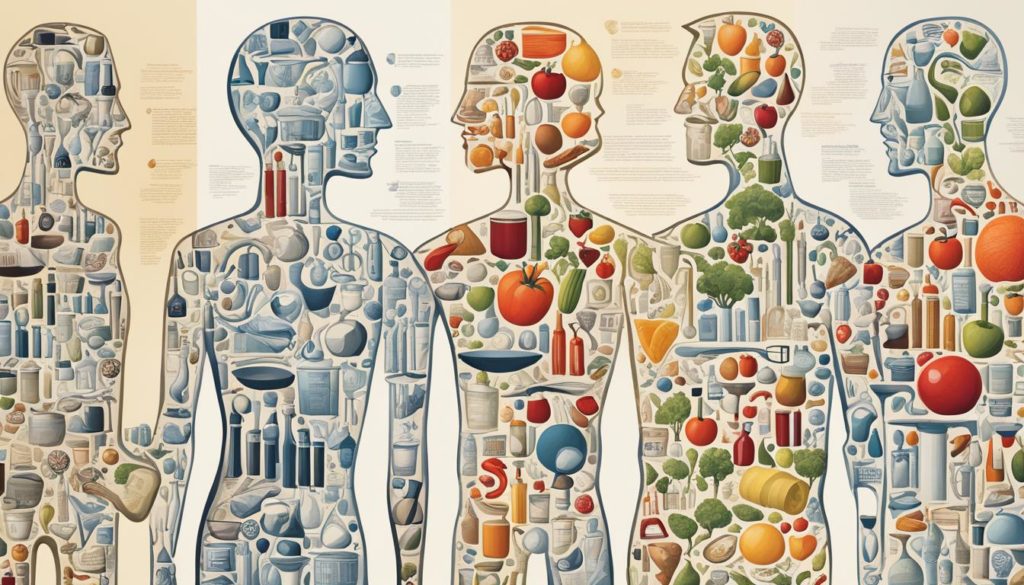Did you know African-American men face a much higher risk of dying from prostate cancer than Caucasian men? This fact points to the big impact society has on prostate cancer risks. It shows this illness doesn’t hit every group the same way.
We’re looking into how social elements influence prostate cancer risk. Things like income, race, where you live, and education matter a lot. They shape who gets prostate cancer and how well they fight it off. This article sheds light on why African-American men, in particular, have a tougher battle. It’s partly because they often have less access to healthcare and different economic backgrounds.
Key Takeaways
- Socioeconomic status significantly impacts prostate cancer risk and outcomes.
- African-American men face more than double the mortality rate from prostate cancer compared to Caucasian men.
- Access to healthcare and early screening is crucial in managing prostate cancer effectively.
- Racial and ethnic disparities in prostate cancer highlight the need for tailored public health strategies.
- Educational levels influence awareness and decisions regarding prostate cancer treatment.
- Neighborhood and living conditions are contributing factors to the risk of developing prostate cancer.
Introduction to Prostate Cancer and its Prevalence
Prostate cancer is the second most common cancer among men in the United States. Understanding its prevalence and the social disparities involved is key. This knowledge helps us tackle its effects better.
General Overview
Prostate cancer occurs when cells in the prostate gland grow uncontrollably. It mainly affects older men. Risk factors include age, family history, and race.
Access to healthcare, education, and socioeconomic status are crucial social factors. They affect the likelihood of developing prostate cancer.

Those diagnosed with prostate cancer have high survival rates. Yet, there are still disparities, especially in marginalized groups. This shows we have progress to make in treatments and equity.
Statistics and Trends in the United States
In the U.S., prostate cancer affects different racial and ethnic groups unequally. Recent data shows most men survive five years or more after diagnosis. However, Black men have a higher prevalence and death rate. This highlights the need to fight both prostate cancer and social disparities.
| Racial Group | Incidence Rate (per 100,000) | Mortality Rate (per 100,000) |
|---|---|---|
| White Men | 100 | 19 |
| Black Men | 176 | 38 |
| Asian-American Men | 78 | 12 |
| Hispanic Men | 86 | 20 |
Improving prostate cancer outcomes means addressing the social determinants. We need holistic, community-based, and policy-driven solutions. This way, the health system can better support everyone affected by the disease.
Socioeconomic Status and Its Impact on Prostate Cancer Risk
The link between socioeconomic status and prostate cancer risk is crucial to understand. Income, education, and employment differences deeply affect prostate cancer results. These differences shape healthcare access, how often people get screened, and their health outcomes.

Income and Access to Healthcare
Income level plays a big role in reaching healthcare services, including prostate cancer screenings. People with more money usually have better healthcare access. This means they get diagnosed earlier which leads to better health results. However, those earning less may not get the healthcare they need on time. This can cause a late diagnosis and more serious cancer stages.
Education Levels and Screening Rates
Education is key in understanding health needs. Those who have more education often know more about the need for regular screenings. This knowledge leads to early disease detection. But, those with less education might not know as much about keeping their prostate healthy. This results in fewer screenings and worse health outcomes.
Employment and Health Insurance
Having a job and health insurance heavily influences prostate cancer risks. Jobs with good health plans help people afford necessary health screenings. Without a stable job or insurance, people find it hard to get healthcare. This can increase the chances of being diagnosed late and facing difficult health challenges. The role of employment and insurance in health is clear.
Racial and Ethnic Disparities in Prostate Cancer
Racial and ethnic differences greatly impact prostate cancer outcomes in the U.S. Various factors, like genetics and healthcare access, play a role. Knowing how different communities suffer can help craft better health solutions.
Prevalence Among Different Racial Groups
Prostate cancer impacts racial groups in various ways. Black men see higher rates than White men. This highlights the need for more research into social and biological reasons.
Comparison Between Black and White Men
Comparing Black and White men shows a clear difference. Black men not only have higher rates but also face worse survival chances. This situation calls for research and healthcare efforts to reduce the disparity.
Studies on Asian-American and Hispanic Men
Asian-American and Hispanic men have distinct prostate cancer risks. Research indicates differences in rates, affected by social factors and cancer vulnerability. Issues like immigration and cultural factors demand specific medical and public health approaches.
Possible Reasons for Disparities
Many factors explain the prostate cancer disparities among racial and ethnic groups. Causes include genetic risks, uneven healthcare access, and the social setting. Understanding these can help clarify risks and improve health strategies.
Influence of Social Environment on Prostate Cancer Development
The area where people live can greatly affect prostate cancer risks. This includes things like how safe the neighborhood is, its conditions, and how connected people feel to others.
Community Safety and Support Systems
Safe communities and strong support networks matter a lot in dealing with prostate cancer. Areas with low crime rates often have better healthcare access. They encourage habits that keep people healthy.
Support from family, friends, and groups in the area can push individuals to get regular checks. This early detection can lower prostate cancer risks. Communities that spread awareness about health can also help prevent many risk factors linked to prostate cancer.
Role of Neighborhood and Living Conditions
Where you live and your surroundings also play a big role in prostate cancer. Areas with less money and poor conditions have higher cancer risks. This is because there’s less access to good healthcare, healthy food, and places to exercise.
Poor living conditions can expose people to harmful toxins. These can increase the chance of getting prostate cancer. So, the neighborhood has a big impact on someone’s health.
Social Isolation and Loneliness
Being isolated and feeling lonely are also big factors in prostate cancer. People without social ties are not as likely to stay active, get medical advice early, or join in community health efforts. Lack of social support can lead to more stress, which is connected to a higher risk of cancer, including prostate cancer.
Building strong connections and community bonds is key. It helps lower risks and improves chances of beating the disease.
The Role of Healthcare Access in Managing Prostate Cancer
Having access to good healthcare greatly affects prostate cancer outcomes. The foundation of managing this disease is early detection. This includes regular screenings like PSA tests.
Importance of Early Detection and Screening
Finding prostate cancer early with screenings is key. Communities with better healthcare see more early diagnoses and treatment successes. Screenings catch cancer when it’s more treatable. They also teach men about prostate health and the impact of their environment.
Barriers to Accessing Medical Services
But, getting these needed screenings can be hard for some. Barriers they face include:
- Lack of Insurance: Without insurance, many men skip check-ups. This often leads to finding cancer later.
- Low Income: Not having enough money can stop people from getting medical care on time.
- Geographic Isolation: Men in remote areas struggle to get to specialized healthcare.
These issues lead to uneven outcomes in prostate cancer. It shows the need for big changes. Changes that can help everyone get better healthcare and cancer management.
| Barrier | Impact | Potential Solutions |
|---|---|---|
| Lack of Insurance | Delayed diagnosis, less frequent screenings | Expand coverage options, public health initiatives |
| Low Income | Limited access to healthcare services | Subsidized healthcare programs, financial aid |
| Geographic Isolation | Reduced availability of specialized care | Telemedicine, mobile health clinics |
It’s vital to tackle these barriers. Doing so will improve healthcare access and prostate cancer care. This way, all men can have the chance for early detection and better health results.
Educational Attainment and Prostate Cancer Outcomes
Having a good education helps a lot in dealing with prostate cancer. People with more education know better about the disease. They go for prostate cancer screening more often. This helps in choosing the right treatment and having better health outcomes.
Link Between Education and Awareness
There’s a strong connection between how much you know and your awareness of prostate cancer. People who’ve been to school more often know the symptoms and risks. They go for prostate cancer screening early. This early action helps in fighting the disease better.
Impact on Treatment Decisions
How much education you have also plays a role in choosing treatments. More educated folks understand the different options better. They talk effectively with their doctors. This makes them choose wisely, leading to better health results. Education makes people approach their health proactively. It leads to better understanding and use of health resources.
Prostate Cancer Social Risk Factors
How social issues and personal risk factors mix affects prostate cancer outcomes. Socioeconomic status, showing in income, education, and healthcare access, is key. People with lower income often struggle to get healthcare quickly. This makes their cancer more serious and limits their treatment choices.
Race and ethnicity play big roles in prostate cancer risks. African American men face higher risks and get diagnosed later than white men. Healthcare disparities over time contribute to this. Hispanic and Asian-American men also have higher risks, for complex reasons. These issues highlight the need to understand prostate cancer’s social sides.
Immigration status adds another layer to prostate cancer risks. Immigrants may deal with language problems and lack of suitable care. This hurts their cancer outcomes. Research, like one in a report on social determinants of prostate cancer, shows these differences have big effects.
Neighborhoods and social networks also impact prostate cancer risk. Areas with strong support and safety see better health results. Being isolated or lonely, however, raises risks and makes recovery harder.
To tackle prostate cancer’s social aspects, we need a broad approach. This means considering socioeconomic, racial, and immigration statuses, plus the social environment. Integrating these into care models can lower disparities and improve prognoses.
Geographic Variability in Prostate Cancer Incidence
Prostate cancer incidence varies widely across different places. Knowing the differences in prostate cancer rates by location can lead to better approaches and outcomes for patients.
Urban vs. Rural Differences
Urban and rural areas show different rates of prostate cancer. Cities often see more cases detected due to better access to healthcare and advanced screenings. But, rural areas sometimes struggle with fewer medical resources, leading to later diagnoses. This shows the need to make healthcare resources available everywhere equally.
County-Level Analysis
Looking at prostate cancer statistics by county shows clear differences within states. Local prostate cancer rates are influenced by income, the environment, and availability of care. A detailed study found that poorer areas with less education see more deaths from prostate cancer. This points out how money and education levels impact health.
State-by-State Comparisons
Comparing states sheds light on prostate cancer variances. States with strong healthcare and better socioeconomic conditions often have better cancer outcomes. Research shows that states with good screening programs usually report fewer prostate cancer deaths. This stresses the need for policies that reduce these health differences, especially between rural and urban areas.
In the end, knowing how prostate cancer rates change by location helps identify who is at higher risk. It also guides in making policies that lessen these health gaps.
The Effect of Immigration Status on Prostate Cancer Risk
Immigrant status adds complexity to prostate cancer risk analysis. Native-born people differ from immigrants due to socio-cultural and economic factors. These factors cause disparities in prostate cancer stats.
Immigrants’ time in the new country, lifestyle changes, and healthcare access affect their risk. It’s important to understand these differences to improve health outcomes.
Comparing Native and Immigrant Populations
Research shows a big difference in prostate cancer rates between natives and immigrants. Immigrants face challenges like language barriers and limited money. These challenges make it hard for them to get screening and treatment.
These obstacles impact their ability to find and treat prostate cancer early. Making healthcare more accessible to them is key.
Studies on Specific Immigrant Groups
Looking into specific immigrant groups sheds more light on this issue. Studies focus on Asian-American, African, and Hispanic groups. Cultural beliefs, diet, and healthcare integration influence their cancer risk and outcomes.
To truly understand this situation, we need a detailed approach. It involves looking at social factors and medical access. Creating targeted health programs for immigrants is vital in managing prostate cancer risk.
FAQ
What are the key prostate cancer social risk factors?
Important factors include socioeconomic status, race, and where you live. Education also plays a big role in prostate cancer risks and outcomes.
How prevalent is prostate cancer in the United States?
Prostate cancer is very common among U.S. men, being the second most common type. Most men live for five years or more after being diagnosed. However, African-American men face a higher risk and death rate than Caucasian men.
How does socioeconomic status (SES) impact prostate cancer risk?
Having a lower SES often means less access to healthcare and fewer screenings. This leads to late discovery of the cancer and worse results. On the other hand, people with higher SES tend to get screened more often, catching the cancer early.
What racial and ethnic disparities exist in prostate cancer prevalence?
Black men face a higher chance of getting prostate cancer and a lower chance of survival than White men. Asian-American and Hispanic men face different risks. These can be due to their immigration status or how easily they can access healthcare.
How does the social environment affect prostate cancer development?
Your community and its conditions can increase your cancer risk. Poor neighborhoods might be riskier. Feeling alone or isolated can also raise the risk of getting cancer.
Why is healthcare access crucial in managing prostate cancer?
Catching prostate cancer early and regular check-ups are key. Lack of insurance or living far from healthcare can lead to finding cancer too late. This makes treatment less likely to succeed.
How does educational attainment influence prostate cancer outcomes?
Better education means being more informed and making smarter health choices. This results in better treatment successes because patients understand their options. They can also talk more effectively with their doctors.
What are the societal influences on prostate cancer risk?
Society affects prostate cancer risk through things like income, race, and education. Having support and where you live also matter. These all shape your risk and how well you might recover.
How do geographic differences affect prostate cancer incidence?
Where you live—city or countryside—impacts your chances of getting prostate cancer. Things like environment, healthcare availability, and local wealth gaps play a role.
What is the effect of immigration status on prostate cancer risk?
Immigrants might see different risks and results with prostate cancer. This depends on how long they’ve been in a new country, lifestyle changes, and their healthcare access.


